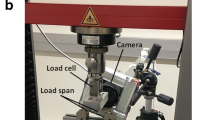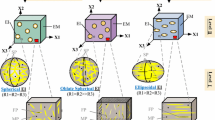Abstract
A virtual design method for medium density fiberboards (MDF) is proposed with the aim to optimize the fiber orientation and lay-up of MDF. The new method estimates the stiffness and strength by using microstructure models of the MDF fiber network. The virtual design is used to improve the manufacturing technology of MDF plates with multilayer oriented fiber structure. Experimental investigations of the mechanical behavior of MDF microstructure for various fiber geometries, glue content and distribution are complicated, time consuming and expensive. On the other side, virtual microstructure design allows to develop a new wood fiber based material with less experimental work. Microstructure models help to better understand the non-linear damage mechanical behavior of a wood fiber network depending on fiber geometrical parameters. Such parameters as crack distribution and fiber deformation on micro-scale level are complicated to experimentally measure, but possible to model using computer simulations. The virtual design tool requires less empirical data. The model takes into account information on average wood fiber orientation, fiber diameter, fiber length and mechanical properties of wood fiber cell wall and glue. The numerical method for strength and stiffness analysis of MDF microstructure was calibrated using standard MDF with non-oriented fibers. It turned out that this method gives precise results for MDF with oriented fibers and even with multilayer structure. The proposed virtual microstructure design tool can significantly improve and speed-up the optimization manufacturing technology of MDF and other wood fiber based composites.













Similar content being viewed by others
References
Andre N, Cho H, Baek S, Jeong M, Young T (2008) Prediction of internal bond strength in a medium density fiberboard process using multivariate statistical methods and variable selection. Wood Sci Technol 42(7):521–534
Deng Q, Li S, Chen Y (2012) Mechanical properties and failure mechanism of wood cell wall layers. Comput Mater Sci 62:221–226
Eichhorn S, Young R (2003) Deformation micromechanics of natural cellulose fibre networks and composites. Compos Sci Technol 63:1225–1230
Feyel F, Chaboche JL (2000) Fe2 multiscale approach for modelling the elastoviscoplastic behaviour of long fibre SiC/Ti composite materials. Comput Methods Appl Mech Eng 183(3–4):309–330
Groom L, Mott L, Shaler S (1999) Relationship between fiber furnish properties and the structural performance of MDF. 33rd International Particleboard/Composite Materials Symposium Proceedings, 89–100
Heyden S (2000) Network modelling for the evaluation of mechanical properties of cellulose fiber fluff. PhD thesis, Division of Structural Mechanics, LTH, Lund University
Isaksson P, Dumont P, du Roscoat SR (2012) Crack growth in planar elastic fiber materials. Int J Solids Struct 49(13):1900–1907
Joffe R, Andersons J, Sparnins E (2009) Applicability of Weibull strength distribution for cellulose fibers with highly non-linear behaviour. In: ICCM 17, Edinburgh: 17th International Conference on Composite Materials, 27 Jul 2009–31 Jul 2009, Edinburgh International Convention Centre, Edinburgh, UK
Kulachenko A, Uesaka T (2012) Direct simulations of fiber network deformation and failure. Mech Mater 51:1–14
Li H, Wang W, Matsubara T (2014) Multiscale analysis of damage progression in newly designed UACS laminates. Compos Part A Appl Sci Manuf 57:108–117
Lippe D (2013) Process development for the experimental proof of property changes of mdf with oriented fibers (in German). Master’s thesis, Fraunhofer-Institut für Holzforschung, Wilhelm-Klauditz- Institut and University of Applied Sciences in Eberswalde (HNEE), Germany
Liu J, Chen Z, Wang H, Li K (2011) Elasto-plastic analysis of influences of bond deformability on the mechanical behavior of fiber networks. Theor Appl Fract Mech 55:131–139
Matsumoto N, Nairn J (2009) The fracture toughness of medium density fiberboard (MDF) including the effects of fiber bridging and crack–plane interference. Eng Fract Mech 76:2748–2757
Merkert D (2013) Voxel-based fast solution of the Lippmann–Schwinger equation with smooth material interfaces. Master’s thesis, TU Kaiserslautern, Germany
Moulinec H, Suquet P (1998) A numerical method for computing the overall response of nonlinear composites with complex microstructure. Comput Methods Appl Mech Eng 157(12):69–94
Osemeahon S, Barminas J (2007) Study of some physical properties of urea formaldehyde and urea proparaldehyde copolymer composite for emulsion paint formulation. Int J Phys Sci 2(7):169–177
Persson K (2000) Micromechanical modeling of wood and fiber properties. PhD thesis, Department of Mechanics and Materials, Lund University
Qing H, Mishnaevsky L (2010) 3D constitutive model of anisotropic damage for unidirectional ply based on physical failure mechanisms. Comput Mater Sci 50:479–486
Rafsanjani A, Lanvermann C, Niemz P, Carmeliet J, Derome D (2013) Multiscale analysis of free swelling of norway spruce. Compos Part A Appl Sci Manuf 54:70–78
Redenbach C, Rack A, Schladitz K, Wirjadi O, Godehardt M (2012) Beyond imaging: on the quantitative analysis of tomographic volume data. Int J Mater Res 103(2):217–227
Schirp A, Mannheim M, Plinke B (2014) Influence of refiner fibre quality and fibre modification treatments on properties of injection-moulded beech wood–plastic composites. Compos Part A Appl Sci Manuf 61:245–257
Schmid HG, Schmid GP (2006) Characterisation of high aspect ratio objects using the powdershape quantitative image analysis system. In: European Congress and Exhibition on Powder Metallurgy (EURO PM), Diamond tooling, vol. 3, Ghent, Belgium, 23–25.10.2006
Sliseris J (2013) Numerical prediction for the modulus of elasticity of lmdf plates. In: Young researcher symposium (YRS) 2013, November 8, Fraunhofer-Zentrum Kaiserslautern, pp 42–47
Sliseris J, Rocens K (2010) Curvature analysis for composite with orthogonal, asymmetrical multilayer structure. J Civ Eng Manage 16(2):242–248
Sliseris J, Rocens K (2013a) Optimal design of composite plates with discrete variable stiffness. Compos Struct 98:15–23
Sliseris J, Rocens K (2013b) Optimization of multispan ribbed plywood plate macrostructure for multiple load cases. J Civ Eng Manage 19(5):696–704
Sliseris J, Andrä H, Kabel M, Dix B, Plinke B, Wirjadi O, Frolovs G (2014) Numerical prediction of the stiffness and strength of medium density fiberboards. Mech Mater 79:73–84
Somer D, Perić D, de Souza Neto E, Dettmer W (2014) On the characterisation of elastic properties of long fibre composites using computational homogenisation. Comput Mater Sci 83:149–157
Souza F, Castro L, Camara S, Allen D (2011) Finite-element modeling of damage evolution in heterogeneous viscoelastic composites with evolving cracks by using a two-way coupled multiscale model. Mech Compos Mater 47(1):133–150
Wilbrink D, Beex L, Peerlings R (2013) A discrete network model for bond failure and frictional sliding in fibrous materials. Int J Solids Struct 50:1354–1363
Wirjadi O, Godehardt M, Schladitz K, Wagner B, Rack A, Gurka M, Nissle S, Noll A (2014) Characterization of multilayer structures in fiber reinforced polymer employing synchroton and laboratory X-ray CT. Int J Mater Res 105(7):645–654
Woodson GE (1977) Density profile and fiber alignment in fiberboard from three southern hardwoods. For Products J 27(8):29–34
Wriggers P, Zavarise G (1997) On contact between three-dimensional beams undergoing large deflections. Commun Numer Methods Eng 13:429–438
Acknowledgments
The project IGF 17644N “Simulation-supported development of medium density fiberboards for lightweight constructions” of the International Association for Technical Issues (iVTH) was funded through the German Federation of Industrial Research Associations (AiF) in the program for promoting the Industrial Collective Research (IGF) of the Federal ministry for economic Afairs and Energy (BMWi) on the basis of a decision of the German Bundestag. The research leading to these results has received the funding from Latvia state research programme under grant agreement’’INNOVATIVE MATERIALS AND SMART TECHNOLOGIES FOR ENVIRONMENTAL SAFETY, IMATEH’’. The research leading to these results has received the funding from Riga Technical University, Faculty of Building and Civil Engineering Grant “DOK.BIF”. Thanks to GE Sensing & Inspection Technologies GmbH for µCT-images.
Author information
Authors and Affiliations
Corresponding author
Rights and permissions
About this article
Cite this article
Sliseris, J., Andrä, H., Kabel, M. et al. Virtual characterization of MDF fiber network. Eur. J. Wood Prod. 75, 397–407 (2017). https://doi.org/10.1007/s00107-016-1075-5
Received:
Published:
Issue Date:
DOI: https://doi.org/10.1007/s00107-016-1075-5




